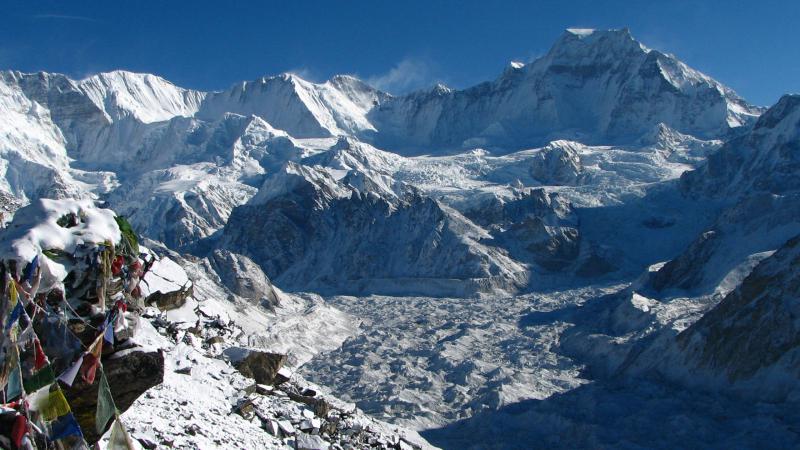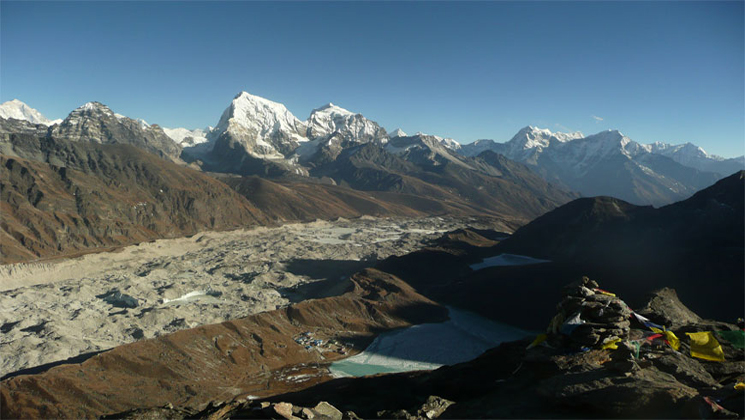Sagarmatha National Park
- Sagarmatha is an exceptional area with dramatic mountains, glaciers and deep valleys, dominated by Mount Everest, the highest peak in the world (8,848 m).
- Several rare species, such as the snow leopard and the lesser panda, are found in the park.
- The presence of the Sherpas, with their unique culture, adds further interest to this site.
- National Park Fee : Rs 1000
- TIMS Permit require for every foreigner trekkers Cost : $20
Mount Everest
Mt. Everest (Sagarmatha) world heritage side of Nepal
The Sagarmatha National Park includes the highest point of the Earth's surface, Mount Everest (Sagarmatha). The park is also of major religious and cultural significance in Nepal as it abounds in holy places such as the Thyangboche and also is the homeland of the Sherpas whose way of life is unique, compared with other high-altitude dwellers.
The park encompasses the upper catchments of the Dudh Kosi River system, which is fan-shaped and forms a distinct geographical unit enclosed on all sides by high mountain ranges. The northern boundary is defined by the main divide of the Great Himalayan Range, which follows the international border with the Tibetan Autonomous Region of China. In the south, the boundary extends almost as far as Monjo.
This is a dramatic area of high, geologically young mountains and glaciers. The deeply-incised valleys cut through sedimentary rocks and underlying granites to drain southwards into the Dudh Kosi and its tributaries, which form part of the Ganges River system. The upper catchments of these rivers are fed by glaciers at the head of four main valleys, Chhukhung, Khumbu, Gokyo and Nangpa La. Lakes occur in the upper reaches, notably in the Gokyo Valley, where a number are impounded by the lateral moraine of the Ngozumpa Glacier (at 20 km the longest glacier in the park). There are seven peaks over 7,000 m. The mountains have a granite core flanked by metamorphosed sediments and owe their dominating height to two consecutive phases of upthrust. The main uplift occurred during human history, some 500,000-800,000 years ago. Evidence indicates that the uplift is still continuing at a slower rate, but natural erosion processes counteract this to an unknown degree.
In the region there are six altitudinal vegetation classed, from oak forests at the lowest elevations to lichens and mosses at the highest elevations. The Himalayan zone provides the barrier between the Palaearctic realm and the Indomalayan realm.
Most of the park (69%) comprises barren land above 5,000 m, 28% is grazing land and about 3% is forested. Six of the 11 vegetation zones in the Nepal Himalaya are represented in the park: lower subalpine; upper subalpine; lower alpine; upper alpine; and subnival zone. Oak used to be the dominant species in the upper montane zone but former stands of this species.
In common with the rest of the Nepal Himalaya, the park has a comparatively low number of mammalian species, apparently due to the geologically recent origin of the Himalaya and other evolutionary factors. The low density of mammal populations is almost certainly the result of human activities. Larger mammals include common langur, jackal, a small number of wolf, Himalayan black bear, red panda, yellow-throated marten, Himalayan weasel, masked palm civet, snow leopard, Himalayan musk deer, Indian muntjac, serow, Himalayan tahr and goral. Sambar has also been recorded. Smaller mammals include short-tailed mol, Tibetan water shrew, Himalayan water shrew; marmot, woolly hare, rat and house mouse.
Inskipp lists 152 species of bird, 36 of which are breeding species for which Nepal may hold internationally significant populations. The park is important for a number of species breeding at high altitudes. The park's small lakes, especially those at Gokyo, are used as staging points for migrants. A total of six amphibians and seven reptiles occur or probably occur in the park.
There are approximately 2,500 Sherpa people living within the park. The people are primarily Tibetan Buddhists. Their activities are primarily agricultural or trade based. Their properties have been excluded from the park by legal definition. There is and will continue to be an influence on the people by the park and vice versa. The Sherpas are of great cultural interest, having originated from Salmo Gang in the eastern Tibetan province of Kham, some 2,000 km from their present homeland. They probably left their original home in the late 1400s or early 1500s, to escape political and military pressures, and later crossed the Nangpa La into Nepal in the early 1530s. They separated into two groups, some settling in Khumbu and others proceeding to Solu. The two clans (Minyagpa and Thimmi) remaining in Khumbu are divided into 12 subclans. Both the population and the growth of the monasteries took a dramatic upturn soon after that time. The Sherpas belong to the Nyingmapa sect of Tibetan Buddhism, which was founded by the revered Guru Rimpoche who was legendarily born of a lotus in the middle of a lake. There are several monasteries in the park, the most important being Tengpoche.
Popular trekking package is Sagarmatha (Everest area)
Tengboche Monastery
- The monastery was built in 1916 by Lama Gulu with strong links to its mother monastery known as the Rongbuk Monastery in Tibet.
Mount Everest
Tengboche Monastery
Tengboche Monastery (or Thyangboche Monastery), also known as Dawa Choling Gompa, located in the Tengboche village in Khumjung in the Khumbu region of eastern Nepal is a Tibetan Buddhist Monastery of the Sherpa community. Situated at 3,867 metres (12,687 ft), the monastery is the largest gompa in the Khumbu region of Nepal.
The monastery was built in 1916 by Lama Gulu with strong links to its mother monastery known as the Rongbuk Monastery in Tibet. However, in 1934, it was destroyed by an earthquake and was subsequently rebuilt. In 1989, it was destroyed for a second time by a fire and then rebuilt with the help of volunteers and international assistance.
Tengboche monastery located amidst the Sagarmatha National Park (a UNESCO World Heritage Site of "outstanding universal value", is draped with a panoramic view of the Himalayan Mountains, including the well known peaks of Tawache, Everest, Nuptse, Lhotse, Ama Dablam, and Thamserku.
Tengboche is also the terminus site of the "Sacred Sites Trail Project" of the Sagarmatha National Park that attracts large number of tourists for trekking and mountaineering. It is a circular trail that covers 10 monasteries in a clockwise direction terminating in the Tengboche Monastery.
 Actual Adventure Pvt. Ltd.
Actual Adventure Pvt. Ltd. Actual Adventure Pvt. Ltd.
Actual Adventure Pvt. Ltd. 

























